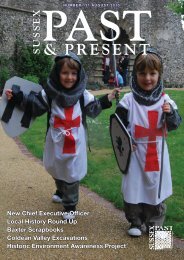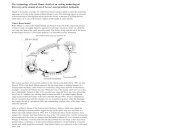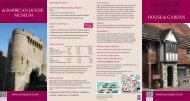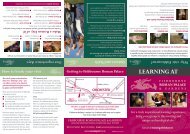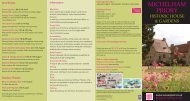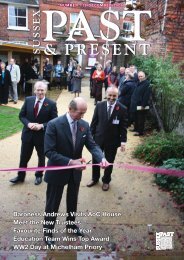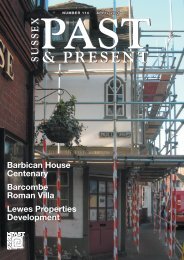April 2013 (issue 129) - The Sussex Archaeological Society
April 2013 (issue 129) - The Sussex Archaeological Society
April 2013 (issue 129) - The Sussex Archaeological Society
- No tags were found...
You also want an ePaper? Increase the reach of your titles
YUMPU automatically turns print PDFs into web optimized ePapers that Google loves.
Excavations<br />
BREDE HIGH WOODS<br />
PLASHETT PARK<br />
Research Feature<br />
Brede High Woods ‘Big Dig’<br />
Successful first year uncovers remains of farm buildings<br />
<strong>The</strong> Woodland Trust, which<br />
acquired Brede High Woods (6<br />
miles north of Hastings, East <strong>Sussex</strong>,<br />
NGR TQ793201) in 2007, secured a<br />
‘Your Heritage’ HLF grant of £50k<br />
to run a community archaeology<br />
project to help uncover more<br />
about the archaeology and history<br />
of this 262 hectare site. <strong>The</strong> grant<br />
runs from October 2011 to June<br />
2014. Chris Butler <strong>Archaeological</strong><br />
Services is leading the project on<br />
behalf of the Woodland Trust and<br />
we have successfully completed a<br />
rewarding first year of investigations<br />
during which we attracted over 100<br />
volunteers, some of whom regularly<br />
turned up in what were, at times,<br />
truly appalling weather conditions.<br />
<strong>The</strong> year started fine and dry when<br />
we surveyed a gill stream in Thorp’s<br />
Wood to investigate a potential early<br />
iron working site. Various lumps of<br />
the waste product of iron making<br />
(slag) and the baked clay remains<br />
of the furnace lining were found. A<br />
Roman coin, found in the vicinity<br />
of the site late last year, has been<br />
dated to the Emperor Valens, circa<br />
364-378 AD. We shall return to this<br />
site in <strong>April</strong> <strong>2013</strong> for a three-week<br />
period of excavation and surveying<br />
in the immediate area.<br />
Our first dig of the year was on<br />
the site of Brede High Farm, where<br />
over a period of three weeks more<br />
than 25 volunteers worked on the<br />
site carrying out a range of activities<br />
including excavation, recording<br />
and finds processing. Together<br />
with a combination of geophysical<br />
surveys, looking at old maps and<br />
excavation, some foundations of<br />
the farmhouse were found but it<br />
was the farm buildings that were<br />
easier to locate. <strong>The</strong>se included<br />
pigsties and the foundations of<br />
an oasthouse. A large amount of<br />
building material, pottery, glass<br />
and metal was recovered during<br />
Excavating the iron working site, Brede High Woods.<br />
the excavation which was cleaned<br />
up and is now in the hands of<br />
specialists for analysis. Most of<br />
the finds date to the late 19th and<br />
early 20th century, though some<br />
are possibly earlier. <strong>The</strong> site was<br />
backfilled, although some of the<br />
walls have been left exposed.<br />
Further work will be carried out<br />
here this year and this will hopefully<br />
make it easier for the casual visitor<br />
to understand what now remains.<br />
<strong>The</strong> house was first recorded on<br />
a map in 1767 and probably dates<br />
to the late 17th century. It was<br />
comprehensively demolished in<br />
the 1930’s when the Powdermill<br />
reservoir was being built.<br />
We then moved to the site of<br />
Austford House and its coach<br />
house. Initially the walls of the coach<br />
house were stabilised as they were<br />
in danger of collapsing. In October<br />
the floors of the coach house were<br />
cleared of metres of mud and debris,<br />
revealing some interesting features<br />
which included a deep, render-lined<br />
waterproof tank, which under the<br />
wet conditions soon filled up with<br />
Photo: V Blandford<br />
water. <strong>The</strong> yard between the coach<br />
house and the foundations of the<br />
house was exposed. A large, well<br />
built cellar with a complete flight of<br />
steps was uncovered and, on the<br />
south facing front of the house,<br />
a substantial bay window and<br />
porch were revealed. This site was<br />
backfilled in November.<br />
We are also carrying out oral,<br />
documentary and historical<br />
research. We were lucky enough<br />
to interview a local man who had<br />
lived at Brede High Farmhouse just<br />
prior to its demolition and he was<br />
able to fill in some valuable details<br />
about the scullery, water pump and<br />
locations of the toilets in a shed<br />
at the bottom of the garden. He<br />
was also able to provide us with a<br />
picture of the farmhouse.<br />
If you would like to take part in<br />
this project please contact Chris<br />
Butler Associates via email brede@<br />
cbasltd.co.uk or call 01323<br />
811785.<br />
Vivienne Blandford<br />
Even some woods and farms<br />
in <strong>Sussex</strong> have names which<br />
are known in different forms round<br />
the world. One example is Plashett<br />
Park, Wood and Park Farm located<br />
north-east of Ringmer, near Lewes.<br />
Plashett Park was a gentleman’s<br />
hunting park and the gentleman<br />
concerned in this case was the<br />
Archbishop of Canterbury until the<br />
Dissolution when it was acquired<br />
by the Gage family.<br />
Location of Plashett Park Image: J Kay, SAC 138<br />
In the early 14th century there<br />
were, according to South East from<br />
AD1000 (Brandon & Short), 380 deer<br />
parks for hunting in Kent, Surrey<br />
and <strong>Sussex</strong>; the possession of a<br />
park had become a status symbol,<br />
even for knights and the lesser<br />
gentry. So it is not surprising that<br />
almost adjoining Broyle Park (the<br />
name of which is derived from the<br />
old French breuil, meaning hunting<br />
park, see the writer’s article in this<br />
What’s in a Name<br />
From Cardinal Richelieu to Plashett Park<br />
journal of August 2005) there were<br />
others nearby, and one is called<br />
Plashett Park.<br />
Mawer & Stenton’s ‘Place<br />
Names of <strong>Sussex</strong>’ tells us that<br />
the name is of Romance origin<br />
from the Late Latin plessetum,<br />
plassetum a woven enclosure.<br />
Why woven Because the fence<br />
was of living wood with interlacing<br />
branches (Delisle, L’Agriculture en<br />
Normandie au moyen age). Sharing<br />
similar etymology are English<br />
words like pleached and plaited.<br />
<strong>The</strong>re are similar names in Essex<br />
(Pleshey), Herefordshire (Platch),<br />
Hertfordshire (Plashes), Norfolk<br />
(Plasset), Northumberland (Plessey<br />
Woods), and even in London, East<br />
Ham, where Plashet Grove still<br />
exists (Weinreb & Hibbert’s London<br />
Encyclopedia and Reaney’s Essex,<br />
EPNS).<br />
<strong>The</strong> fence or hedge was, in the<br />
case of our Plashett, intended<br />
to keep the deer in the park.<br />
But elsewhere it was used as a<br />
fortification, to keep people out.<br />
<strong>The</strong> corresponding name in France<br />
is Plessis and it is widespread in<br />
the northern part of that country<br />
because there the emphasis is<br />
not on keeping animals in (the<br />
appropriate name for which is parc)<br />
but on keeping humans out. It is the<br />
name of a chateau, a fortification.<br />
Nine place names are listed in the<br />
Paris region alone (Noms de Lieux<br />
d’Ile-de-France by Marianne Mulon),<br />
the strangest of which is Plessis-<br />
Robinson, a Plessis which was first<br />
mentioned in 839 and was named<br />
progressively, Plessis–Raoul,<br />
Plessis-Piquet, Plessis-Liberté at<br />
the time of the Revolution, back<br />
again to Plessis-Piquet in 1801 and<br />
finally, in 1909 it took on the name<br />
of a cafe/dance hall named after<br />
Swiss Family Robinson, the name<br />
of which was inspired by Robinson<br />
Crusoe.<br />
We must not forget the family and<br />
business name Plessis and its kin<br />
in this country and elsewhere since<br />
at least 1204 (Gilbert de Plessis,<br />
Oxford Dictionary of Surnames,<br />
Reaney & Wilson). One example<br />
is the family name of Cardinal<br />
Richelieu, Chief Minister of Louis XIII<br />
and claimed to be the world’s first<br />
Prime Minister (Cardinal Armand-<br />
Jean du Plessis de Richelieu). Other<br />
occurrences of the name include<br />
the industrial company Plessey<br />
(now no more), Plessis Armouries,<br />
a South African cricketer (Francis<br />
du Plessis), two rugby players of<br />
distinction (Bismarck and Jannie)<br />
and a former Liverpool footballer<br />
born in the French West Indies<br />
(Damien Plessis).<br />
Finally, a notorious, now overruled,<br />
US Supreme Court case: Plessy v<br />
Ferguson 1896 (races separate but<br />
equal) bears the name.<br />
All this from the name of a<br />
hedge.<br />
Colin Child<br />
<strong>The</strong>ft of millstones from famous <strong>Sussex</strong> landmarks<br />
Five millstones worth £5000 have been stole from the site of the famous Jack and Jill Windmills at Clayton.<br />
<strong>The</strong> demand for unusual garden ornaments is fuelling this type of theft. If you are buying anything of this<br />
nature, please check the <strong>The</strong> Salvo Directory website www.salvo.co.uk which has a list of over 200 items<br />
believed to have been stolen and question any seller carefully as to where your prospective purchase came<br />
from.<br />
<strong>Sussex</strong> Past & Present <strong>April</strong> <strong>2013</strong><br />
www.sussexpast.co.uk www.sussexpast.co.uk <strong>Sussex</strong> Past & Present <strong>April</strong> <strong>2013</strong>



